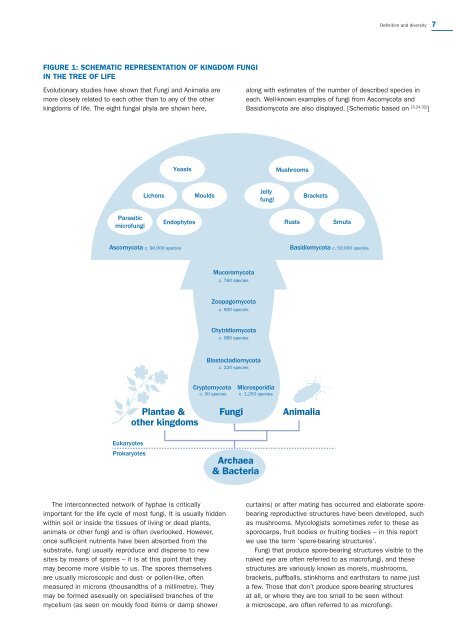gom1
Create successful ePaper yourself
Turn your PDF publications into a flip-book with our unique Google optimized e-Paper software.
Definition and diversity 7<br />
FIGURE 1: SCHEMATIC REPRESENTATION OF KINGDOM FUNGI<br />
IN THE TREE OF LIFE<br />
Evolutionary studies have shown that Fungi and Animalia are<br />
more closely related to each other than to any of the other<br />
kingdoms of life. The eight fungal phyla are shown here,<br />
along with estimates of the number of described species in<br />
each. Well-known examples of fungi from Ascomycota and<br />
Basidiomycota are also displayed. [Schematic based on [3,24,32] ]<br />
Yeasts<br />
Mushrooms<br />
Lichens<br />
Moulds<br />
Jelly<br />
fungi<br />
Brackets<br />
Parasitic<br />
microfungi<br />
Endophytes<br />
Rusts<br />
Smuts<br />
Ascomycota c. 90,000 species<br />
Basidiomycota c. 50,000 species<br />
Mucoromycota<br />
c. 760 species<br />
Zoopagomycota<br />
c. 900 species<br />
Chytridiomycota<br />
c. 980 species<br />
Blastocladiomycota<br />
c. 220 species<br />
Cryptomycota<br />
c. 30 species<br />
Microsporidia<br />
c. 1,250 species<br />
Plantae &<br />
other kingdoms<br />
Fungi<br />
Animalia<br />
Eukaryotes<br />
Prokaryotes<br />
Archaea<br />
& Bacteria<br />
The interconnected network of hyphae is critically<br />
important for the life cycle of most fungi. It is usually hidden<br />
within soil or inside the tissues of living or dead plants,<br />
animals or other fungi and is often overlooked. However,<br />
once sufficient nutrients have been absorbed from the<br />
substrate, fungi usually reproduce and disperse to new<br />
sites by means of spores – it is at this point that they<br />
may become more visible to us. The spores themselves<br />
are usually microscopic and dust- or pollen-like, often<br />
measured in microns (thousandths of a millimetre). They<br />
may be formed asexually on specialised branches of the<br />
mycelium (as seen on mouldy food items or damp shower<br />
curtains) or after mating has occurred and elaborate sporebearing<br />
reproductive structures have been developed, such<br />
as mushrooms. Mycologists sometimes refer to these as<br />
sporocarps, fruit bodies or fruiting bodies – in this report<br />
we use the term ‘spore-bearing structures’.<br />
Fungi that produce spore-bearing structures visible to the<br />
naked eye are often referred to as macrofungi, and these<br />
structures are variously known as morels, mushrooms,<br />
brackets, puffballs, stinkhorns and earthstars to name just<br />
a few. Those that don’t produce spore-bearing structures<br />
at all, or where they are too small to be seen without<br />
a microscope, are often referred to as microfungi.

















